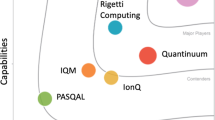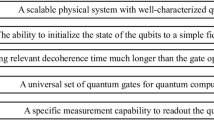Abstract
In this paper we investigate the energy footprint and performance profiling of COSMO-ART on various HPC platforms. This model is an extension of the operational weather forecast model of the German weather service (DWD), developed for the evaluation of the interactions of reactive gases and aerosol particles with the state of atmosphere at the regional scale. Different measurement devices and energy-aware techniques are described to evaluate both time and energy to solution of the considered application and to gain detailed insights into power and performance requirements. Our motivation is to improve corresponding code sections to sustain performance while minimizing energy-to-solution. This preliminary work sets the basis for subsequent studies to tackle challenges related to energy efficient high performance computing in the framework of the Exa2Green project (EU FET Project, http://exa2green.eu/).






Similar content being viewed by others
References
EU FET Project FP7 318793 Exa2Green. http://exa2green.eu/
High performance and high productivity computing. http://www.hp2c.ch/
Ackermann IJ et al (1998) Modal aerosol dynamics model for Europe: development and first applications. Atmos Environ 32(17):2981–2999
Athanasopoulou E et al (2013) Modeling the meteorological and chemical effects of secondary organic aerosol during an EUCAARI campaign. Atmos Chem Phys 13:625–645
Baldauf M et al (2011) Operational convective-scale numerical weather prediction with the COSMO model: description and sensitivities. Mon Weather Rev 139(12):3887–3905
Bangert M et al (2012) Saharan dust event impacts on cloud formation and radiation over Western Europe. Atmos Chem Phys 12:4045–4063
Bangert M, Kottmeier C, Vogel B, Vogel H (2011) Regional scale effects of the aerosol cloud interaction simulated with an online coupled comprehensive chemistry model. Atmos Chem Phys 11:4411–4423
Barreda M et al (2013) A framework for power-performance analysis of parallel scientific applications. In: Third International conference on smart grids, green communications and IT energy-aware technologies-energy, pp 114–119
Barroso LA, Hölzle U (2007) The case for energy-proportional computing. Computer 40(12):33–37
Cumming B, Fourestey G, Fuhrer O, Fatica M, Schulthess TC (2014) Application centric energy-efficiency study of distributed multi-core and hybrid CPU-GPU systems. submitted
Damian V, Sandu A, Damian M, Potra F, Carmichael G (2002) The kinetic preprocessor KPP-a software environment for solving chemical kinetics. Comput Chem Eng 26(11):1567–1579
Diouri MEM, Dolz MF, Glück O, Lefèvre L, Alonso P, Catalán S, Mayo R, Quintana-Ortí ES (2014) Assessing power monitoring approaches for energy and power analysis of computers. J Sustain Comput Inf Syst 4(2):68–82
Doms G (2011) A description of the nonhydrostatic regional COSMO-model. Part I: dynamics and numerics
Fountoukis C, Nenes A (2007) ISORROPIA II: a computationally efficient thermodynamic equilibrium model for \(K^{+}- Ca^{2+}-Mg^{2+}-NH^{+}-Na^{+}-SO2^{-}-NO^{-}-Cl^{-}-HO\) aerosols. Atmos Chem Phys 7:4639–4659
Geiger H, Barnes I, Bejan I, Benter T, Spittler M (2003) The tropospheric degradation of isoprene: an updated module for the regional atmospheric chemistry mechanism. Atmos Environ 37(11):1503–1519
Gysi T, Fuhrer O, Osuna C, Bianco M, Schulthess T (2014) Stella: a domain-specific language and tool for structured grid methods. submitted
IPCC - Intergovernmental Panel on Climate Change (2013) Climate Change 2013: The Physical Science Basis. Working Group I Contribution to the Fifth Assessment Report of the Intergovernmental Panel on Climate Change. Cambridge University Press, Cambridge
Knote C, Brunner D (2013) An advanced scheme for wet scavenging and liquid-phase chemistry in a regional online-coupled chemistry transport model. Atmos Chem Phys 13: 1177–1192
Knote C et al (2011) Towards an online-coupled chemistry-climate model: evaluation of trace gases and aerosols in COSMO-ART. Geosci Model Dev 4(4):1077–1102
Lapillonne X, Fuhrer O (2014) Using compiler directives to port large scientific applications to GPUs: an example from atmospheric science. Parallel Process Lett 24(1):1450003
Lee LA et al (2013) The magnitude and causes of uncertainty in global model simulations of cloud condensation nuclei. Atmos Chem Phys 13:8879–8914
Lundgren K, Vogel B, Vogel H, Kottmeier C (2013) Direct radiative effects of sea salt for the mediterranean region at conditions of low to moderate wind speeds. J Geophys Res 118(4):1906–1923
Mann GW et al (2013) Intercomparison and evaluation of aerosol microphysical properties among AeroCom global models of a range of complexity. Atmos Chem Phys 13:30841–30928
Myhre G et al (2013) Radiative forcing of the direct aerosol effect from Aerocom phase II simulations. Atmos Chem Phys 13:1853–1877
Padoin EL et al (2013) Evaluating application performance and energy consumption on hybrid CPU+GPU architecture. Clust Comput 16(3):511–525
Randles CA et al (2013) Intercomparison of shortwave radiative transfer schemes in global aerosol modeling: results from the AeroCom radiative transfer experiment. Atmos Chem Phys 13:2347–2379
Riemer N, Vogel H, Vogel B (2004) Soot aging time scales in polluted regions during day and night. Atmos Chem Phys 4:1885–1893
Riemer N, Vogel H, Vogel B, Fiedler F (2003) Modeling aerosols on the mesoscale-\(\gamma \): treatment of soot aerosol and its radiative effects. J Geophys Res 108(19):4601–4616
Ritter B, Geleyn JF (1992) A comprehensive scheme for numerical weather prediction models with potential applications in climate simulations. 120(Monthly Weather Review):303–305
Rosenfeld D, Wood R, Donner LJ, Sherwood SC (2013) Aerosol cloud-mediated radiative forcing: highly uncertain and opposite effects from shallow and deep clouds. In: Climate science for serving society: research, modelling and prediction priorities, pp 105–149
Seifert A, Beheng KD (2006) A two-moment cloud microphysics parameterization for mixed-phase clouds. part 1: model description. Meteorol Atmos Phys 92(1–2):45–66
Sherwood SC et al (2013) Climate processes: clouds, aerosols and dynamics. In: Climate science for serving society: research, modelling and prediction priorities, pp 73–103
Stanelle T, Vogel B, Vogel H, Bäumer D, Kottmeier C (2010) Feedback between dust particles and atmospheric processes over West Africa during dust episodes in March 2006 and June 2007. Atmos Chem Phys 10(22):10771–10788
Stier P et al (2013) Host model uncertainties in aerosol radiative forcing estimates: results from the AeroCom Prescribed intercomparison study. Atmos Chem Phys 13:3245–3270
Stockwell WR, Middleton P, Chang JS, Tang X (1990) The second generation regional acid deposition model chemical mechanism for regional air quality modeling. J Geophys Res 95(10):16343–16367
Vogel B et al (2009) The comprehensive model system COSMO-ART: radiative impact of aerosol on the state of the atmosphere on the regional scale. Atmos Chem Phys Discus 9(4):14483–14528
Vogel B, Fiedler F, Vogel H (1995) Influence of topography and biogenic volatile organic compounds emission in the state of Baden-Württemberg on ozone concentrations during episodes of high air temperatures. J Geophys Res 100(11):22907–22928
Vogel B, Hoose C, Vogel H, Kottmeier C (2006) A model of dust transport applied to the dead sea area. Meteorologische Zeitschrift 15(6):611–624
Vogel H, Pauling A, Vogel B (2008) Numerical simulation of birch pollen dispersion with an operational weather forecast system. Int J Biometeorol 52(8):805–814
Wittmann M, Hager G, Zeiser T, Treibig J, Wellein G (2013) An analysis of energy-optimized lattice-Boltzmann CFD simulations from the chip to the highly parallel level. CoRR abs/1304.7664
Acknowledgments
The research leading to these results is supported by the Exa2Green project co-financed by the European Commission under 7th Framework Programme Future and Emerging Technologies (FET) Proactive Initiative: Minimizing Energy Consumption of Computing to the Limit (MINECC). We also gratefully acknowledge the High Performance and High Productivity Computing Initiative [2] for results that will be leveraged in subsequent code refactoring.
Author information
Authors and Affiliations
Corresponding author
Rights and permissions
About this article
Cite this article
Charles, J., Sawyer, W., Dolz, M.F. et al. Evaluating the performance and energy efficiency of the COSMO-ART model system. Comput Sci Res Dev 30, 177–186 (2015). https://doi.org/10.1007/s00450-014-0267-7
Published:
Issue Date:
DOI: https://doi.org/10.1007/s00450-014-0267-7




